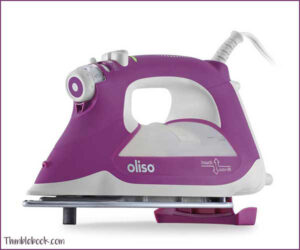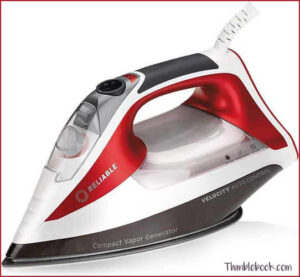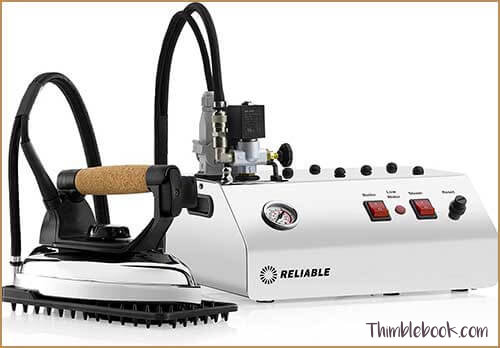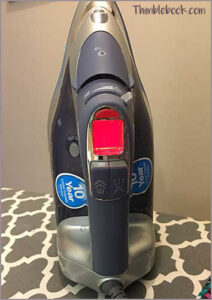How to Select The Best Iron for Sewing Projects
*This post may include affiliate links, which allow me to make a small commission off your purchases. The money is earned at no additional cost to you.
Finding the best iron for sewing projects is only possible after you’ve come to understand the different irons available and which one will best suit your personal desires. So, rather than just spitting out a list of top picks, I will give details about different types of irons so you can make an informed decision about which iron will best suit your personal sewing needs.
How Steam Irons Work
*I’m just going to go over steam irons as these are the most commonly available.
Water moves from the reservoir into the heating chamber. Then, the water must heat to roughly 200 degrees before it becomes steam. Once steam builds up, it is dispersed via variable (automatic) expulsion. Or, steam gets dispelled by pressing the burst button. Most times, the steam can be turned off to give dry heat.
There are 5 basic kinds of irons…
1) Basic home iron
2) Basic home iron marketed toward sewing enthusiast’s
3) Cordless iron
4) Gravity fed professional iron
5) Steam generator iron
Here’s what you need to know about the 5 types
@HOME
90% of home irons have auto shut off to save on the energy bill and prevent house fires. (They vary in the amount of run time before automatic shutoff so check the box before buying). Home irons range from cheap to pricey as the average cell phone bill! Typically, the pricing is based on the quality of the heating element inside of the iron. I’m not going to say all cheap irons are bad. Every once in a while, there will be a great iron on the cheap side.
| Pros | Cons |
| Auto shut off | Auto shut off |
| Readily available |

@Home Sewing Version
Home irons, marketed toward sewing enthusiasts, are just like regular home irons. But, there is a difference. They always offer more time before auto shut off kicks in. As of 2021, the vast majority of sewing geared irons auto-shut off after 30 minutes instead of the average 8 minute shut-off on standard home irons.

A few brands, like Reliable, allow users to 100% disable auto shutoff. *If you decide the best iron for sewing projects is a home sewing iron, plug it into a power strip along with a radio. Radio noise will help you remember to shut the darn thing off. Better yet, get a smart outlet so you can power down remotely via smartphone.
| Pros | Cons |
| Longer iron time without interruption | Costs more than a home iron without added longevity |
| Uses more energy (cost more on energy bill) | |
| No auto shut off |

Panasonic cordless is a great option from the cordless category. The only complaint is the awkward iron shape.
Cordless iron
Cordless irons have a base. They remain warm when on base and start cooling soon as you remove them. These types of irons are wonderful for taking on retreats or for ironing small quilt blocks because they don’t constrict your movement and are ready to iron when you are.
| Pros | Cons |
| Portable | Costs more |
| Doesn’t stay hot as long |

Gravity Fed
Gravity fed irons are designed for professionals. They have a large water tank that suspends from a hook or IV pole for hours of nonstop ironing. In terms of function, gravity fed irons work a little bit different than standard home steam irons. Instead of having variable (automatic) steam, users press a button to release a solenoid valve that lets water into the irons’ heating element for producing steam. Since many of parts in a gravity fed iron are separate, broken elements can easily be replaced. For example, you can replace a :
- Solenoid valve
- Button for releasing the value
- Hose that attaches to the water tank
- The water tank
| Pros | Cons |
| No auto shut off | No auto shut off |
| Made for hours of use per time | Cost more in energy bill + upfront costs |
| Last way longer | Takes up a lot of space |

Steam generator iron
Similar to a gravity fed iron, steam generator irons keep water stored in a separate tank from the iron itself. Water gets pumped from the tank into a high pressure boiler used for converting water to steam. Once steam is produced, it comes out with powerful force.
| Pros | Cons |
| Less time spent replacing water | Takes up more space |
| Easier cleanup of limescale buildup | Costs more |
| Extra large steam output |
Now let’s select the best iron for sewing projects based on a few criteria!
Select an iron with a decent wattage, but don’t go overboard!
Remember: The heating element must heat to around 200 degrees in order to convert the water to steam. If it doesn’t heat hot enough, you’ll get water dripping all over your items. Water stains just aren’t cute.
Therefore, don’t go super low with the wattage if you can help it. Remember, 1500 watts and below means your iron will take longer to heat up. But, that’s ok if your dealing with an outlet situation. (Note: Most USA based outlets are only rated for 15A, which means the maximum wattage accepted is 1800 watts. Too high of a wattage can trip the breaker or even cause a house fire. So, please make sure to not plug anything else in the outlet if you are using a high wattage iron on a low plug load socket).
Low wattage isn’t ideal. However, don’t go too high with the wattage in your iron! Super high wattage equals higher energy consumption and more energy costs. A good middle ground is around 1700watts – the same wattage as your average hair dryer..
If the iron has a cord, you need a long one.
The best iron for sewing projects must not back you into a corner like that 1996 clear corded phone from Radio Shack.
Soleplates are important!
Teflon plates tend to wipe down easier than stainless steel plates. However, teflon coatings tend to scratch more easily. We also cannot go without discussing ceramic. Ceramic is excellent, but don’t get anything fused to the surface because it will be extra hard to get it off! Now, stainless steel glides well but is also very delicate and scratches easily. You’ve got options, but have to decide the best soleplate option based on what you will be ironing!
Don’t forget about the reservoir.
Please make sure to check what kind of water the tank takes. If using distilled water is too much hassle, you may want to look elsewhere for an iron. Also, look at the water capacity because you don’t want a super small water reservoir you’ve got to refill too often.
The right price
Spend what you can, but don’t break the bank because irons can get pretty pricey. Don’t believe me? Check out this Laurastar Smart I All-In-One Ironing System. Happy sewing!
Other Helpful Articles
Do You Really Need a Tutto Sewing Machine Case
Sewing Must Have For Every Basic Emergency Kit List


No Comments